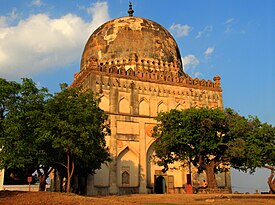Ahmad Shah I Wali
| Ahmed Shah Bahmani I | |
|---|---|
| Wali | |
 | |
| 9th Bahmani Sultan | |
| Reign | 1 October 1422 – 17 April 1436 |
| Predecessor | Taj ud-Din Firuz Shah |
| Successor | ‘Alau’d-din Ahmad Shah |
| Burial | |

Ahmed Shah Al Wali Bahamani was the ruler of the Bahmani Sultanate from 1 October 1422 to 17 April 1436, and was a great patron of arts and culture.[1] He brought Persian artisans from Iran, including the metal-worker Abdulla-bin-Kaiser, who was the master of Bidriware, the inlaying of zinc alloy with silver and gold.[2]
Early life[edit]
Ahmed Shah was a grandson of Alauddin Bahman Shah. He was born sometime around 1371. He, along with his brother Firuz, was raised by Muhammad Shah II.[3] The brothers were married to the daughters of Muhammad Shah II.
Accession of Firuz and killing of Taghalchin[edit]
After the birth of Ghiyas-ud-din, Muhammad deemed him the successor to the throne. However, Ghiyas-ud-din was blinded and imprisoned by a Turkish nobleman, Taghalchin, who installed Shams-ud-din as a puppet ruler. Firuz and Ahmed, marched to Gulbarga and Firuz declared himself the new sultan.
On November 15, 1397, Firuz and Ahmed entered the palace with a few armed men on the pretext of paying their respects to the new king. They overpowered the king as well as Taghalchin, and Firuz ascended the turquoise throne, assuming the title of Taj-ud-din Firuz Shah.
During Firuz Shah's reign[edit]
After Firuz ascended the throne, he made Ahmad a minister and awarded him the titles of Amir al-umara.
Rebellion against Firuz[edit]
In 1422, Firuz ordered Ahmad to be blinded, in order to secure the succession for his eldest son Hasan Khan.[4] Ahmad, along with his son Alauddin and his supporters, fled the capital and was pursued by a force of three or four thousand horse, led by Hushyar and Bidar. In the ensuing battle, Ahmad's army defeated the army of Hushyar and Bidar, as they fell back to Gulbarga with Ahmad in pursuit.[5]
As Ahmad laid siege to Gulbarga, Firuz, now extremely ill, was carried to the battlefield. Rumours of his death caused many in his army to defect to Ahmad's camp.[5] The citadel was surrendered and Firuz abdicated in favour of Ahmad.
Reign[edit]
Ahmed Shah's, and his empress's, tomb is located in Ashtur village, Bidar District,[1][6] and is the subject of an annual urs, or anniversary of death festival.[1][7]
During the reign of Ahmed Shah, in 1432, the Bahmani capital shifted to Bidar, and Khwaja Bandenawaz (d. 1422), the most well-known Sufi of the Deccan, is supposed to have been one of the causes for this. The Bahmani kings had close ties with Sufi saints, and Ahmed Shah continued the tradition but he was also considered a saint; the only king to be treated as such by his followers. His tomb in the funerary complex of Ashtur, just outside Bidar, is venerated by Muslims, who consider him to be a wali (friend of God). Ahmed Shah's tomb has well-preserved murals and verses from the Quran. Frontline</ref>
Ahmed Shah fought battles against Vijayanagar[8] (1423), Warangal (1424–1425), Malwa (1425–1435), and against Gujarat (1425–1435).[citation needed]<ref>
Death[edit]
Ahmad Shah died in 1435[note 1] and was buried in Bidar.
Beliefs[edit]
He was religiously inclined and fond of Sufi saints.[10] He is referred to by the title Wali.[11]
Issue[edit]
- Alauddin Ahmad Shah
- Mahmud Khan
- Daud Khan
- Muhammad Khan
References[edit]
Notes[edit]
Citations[edit]
- ^ a b c Staff (5 March 2007) "Symbol of communal harmony" The Hindu
- ^ Nathanael, M. P. (20 January 2002) "The Sunday Tribune: Spectrum: Travel: Bewitched by Bidar" The Tribune, Chandigarh, India
- ^ Haig, pp. 386.
- ^ Haig, p. 394.
- ^ a b Haig, pp. 395.
- ^ "Bidar:Tomb of Ahmad Shah Baihmani" Institute of Oriental Culture Japan
- ^ Desai, Rishikesh Bahadur (18 April 2005) "A centre for communal harmony comes alive" The Hindu
- ^ Sen, Sailendra (2013). A Textbook of Medieval Indian History. Primus Books. pp. 106–108. ISBN 978-9-38060-734-4.
- ^ Haig, pp. 402.
- ^ Yazdani, 1947, pp. 114.
- ^ Yazdani, 1947, pp. 115.
8. https://frontline.thehindu.com/arts-and-culture/heritage/article25296303.ece
Bibliography[edit]
- Yazdani, Ghulam (1947). Bidar, Its History and Monuments.
- Haig, Wolseley. The Cambridge History Of India Vol. 2. Cambridge University Press.
- Sherwani, Haroon Khan. The Bahmanis of the Deccan. Hyderabad.
